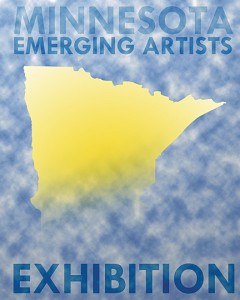In conjunction with 2006-2007 MCAD/Jerome Foundation Fellowship for Emerging Artists Exhibition, I invited all artists who had applied but did not receive the fellowship that year to submit images of work to be projected as part of an exhibition within the exhibition of the finalists.

Each image was projected for 30 seconds in a random rotation. Work could be viewed more leisurely at the two computer stations where each artist had a page with their artist’s statement and 6 images of their work.
A brochure for the exhibition included an essay from a critic on the nature of competition in the arts and the role in the Minnesota art community of large grants from private foundations. Each artist also had a short statement in the brochure about why they were participating in this exhibition, the grant process or competition in the arts.
When I received the MCAD/Jerome Fellowship for Emerging Artists, I was really nonplussed by the apparent arbitrariness of the process. Why did I receive it this year and not the previous one? This feeling of bewilderment increased when I was confronted with the reactions of colleagues and friends, which ranged from genuine congratulations to backhanded compliments. I wanted to explore the context of this grant, and it seemed logical (and most interesting) to do this with artists involved in the process as the focus.
While the process was flawed, the approach seemed logical at the time. I felt pressured to have a clear visual form defined in advance. I also felt that if I proposed a final form when I first contacted artists, they might also understand the sincerity of my intentions. My intent was not a gesture of generosity (I share my exhibition opportunity with you), but rather to expose the arbitrary nature of this process by showing how varied (and excellent) the work of applicants is.
I could not contact the artists personally for privacy reasons, so I developed a form letter outlining my ideas that the gallery mailed to all of the applicants for the 2006/2007 fellowship season. I tried to emphasize that there were open questions and that other forms of display could be proposed. I did not build an adequate structure, however, to engender this participation. I think I thought that a discussion would develop naturally through email or telephone contact, and I underestimated the importance of bringing people together physically in the same space. We did have one meeting of participating artists shortly before the opening of the exhibition, but in retrospect, I would have held casual, no-commitment informational and get-to-know-each-other meetings at the beginning, and additional meetings throughout the exhibition preparation. This may have increased the number of artists participating in the final exhibition, though I do not expect that it would have meant all of them becoming more involved with the planning or structure.
One critique of the project is that it does nothing to reimagine the jurying process, but merely recreates this for the gallery visitors. While my interest and intent were not in reimagining or recreating this process, I would say that a recreation is not without merit. Most jury meetings are closed, and I think it is hard to imagine what that process is actually like. In inadvertently “recreating” the structure of the jury meeting, I would hope that the arbitrary aspects of the process becomes clearer, revealing the difficulties and inherent flaws and perhaps underscoring that the chosen artists should not necessarily be considered “the best”, but what caught the jurors’ eyes on a particular day.
I don’t exactly consider this project “my artwork”, in part because of the ethical issues involved in the work. However, it was an extremely formative and informative process. I was exposed to far more work from artists in Minnesota than I had been previously. My own understanding of the “art scene” in Minneapolis/St. Paul was expanded significantly, and I have been lucky enough to develop relationships with people whom I may never have met otherwise. There is no chance of repeating this project or recreating it, yet each year I am struck by new ideas for how I could have or should have structured it, and I am hopefully able to incorporate this knowledge into my new endeavors.
Note: Since 2007, the jurying process for the fellowship has changed. Previously jurors met and viewed all applications together in a one to two day meeting, then chose a group of ten finalists to be visited in their studios. From these ten finalists, five fellows were chosen. There was no feedback for artists. Jurors now view applications online, individually at their leisure and make a personal shortlist. These shortlists are discussed during a conference call, and a final list of ten finalists is developed. The jurors then visit the finalists in their studios and choose five fellows, as previously. Feedback is now available for at least the ten finalists.